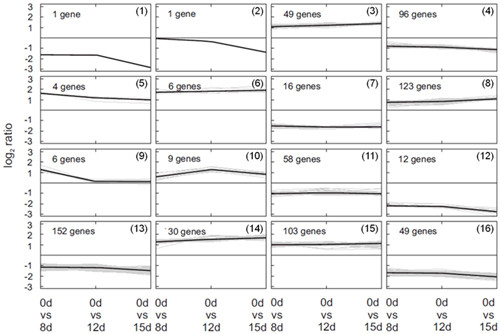PLOS ONE:昆明植物所表明转录水平重新编程是种子老化一个关键
中国科学院昆明植物研究所种质资源库种子生物学研究组陈虹颖博士与英国专家合作,对豌豆种子老化过程中种子活力与基因表达以及谷胱甘肽氧化还原状态之间的关系进行了检测分析。 结果发现,各项实验指标在种子失去活力之前已经发生改变。相关文章发表于2013年10月29日《PLoS ONE》杂志上。

图示.响应老化过程的基因表达聚类分析
种质资源库可以最大限度地延长耐脱水种子(即正常型种子)的寿命,例如玉米种子在昆明室温仅能保藏1年半,而在种质资源库的条件下却能保藏近2000年。然而,即使是如此优越的保藏条件,种子最终还是将面临死亡,因此,解析种子老化过程对于种质资源库的保藏是至关重要的。
研究小组采用基因芯片以及实时定量pcr技术对种子老化过程中的转录水平表达进行了检测。结果显示,当老化过程开始启动,虽然萌发率仍然维持在100%的水平,但部分的DNA和rna已经开始降解,转录分析的数据显示与细胞程序性死亡、氧化胁迫以及泛素蛋白相关的基因在种子失去活力以前就已经发生了改变。当豌豆种子老化25天以后,萌发率开始下降,此时谷胱甘肽的还原电势也朝着正值方向移动(>190mV)。
基于本研究结果,研究人员推测种子老化的过程是一个由基因控制的过程,而且老化过程启动了细胞程序性死亡,最终导致了种子活力的丧失。
该研究运用先进的分子生物学研究手段,揭示了种子老化的分子生物学基础,表明转录水平的重新编程是种子老化的一个关键组成成分,最终将导致程序性死亡,种子活力的丧失。
该研究项目受到了所级项目以及中科院“西部之光”人才项目的资助。
原文摘要:
Transcriptome-wide mapping of pea seed ageing reveals a pivotal role for genes related to oxidative stress and programmed cell death
Hongying Chen equal contributor, Daniel Osuna equal contributor, Louise Colville mail, Oscar Lorenzo, Kai Graeber, Helge Küster, Gerhard Leubner-Metzger, Ilse Kranner
Understanding of seed ageing, which leads to viability loss during storage, is vital for ex situplant conservation and agriculture alike. Yet the potential for regulation at the transcriptional level has not been fully investigated. Here, we studied the relationship between seed viability, gene expression and glutathione redox status during artificial ageing of pea (Pisum sativum) seeds. Transcriptome-wide analysis using microarrays was complemented with qRT-PCR analysis of selected genes and a multilevel analysis of the antioxidant glutathione. Partial degradation of DNA and RNA occurred from the onset of artificial ageing at 60% RH and 50°C, and transcriptome profiling showed that the expression of genes associated with programmed cell death, oxidative stress and protein ubiquitination were altered prior to any sign of viability loss. After 25 days of ageing viability started to decline in conjunction with progressively oxidising cellular conditions, as indicated by a shift of the glutathione redox state towards more positive values (>−190 mV). The unravelling of the molecular basis of seed ageing revealed that transcriptome reprogramming is a key component of the ageing process, which influences the progression of programmed cell death and decline in antioxidant capacity that ultimately lead to seed viability loss.

